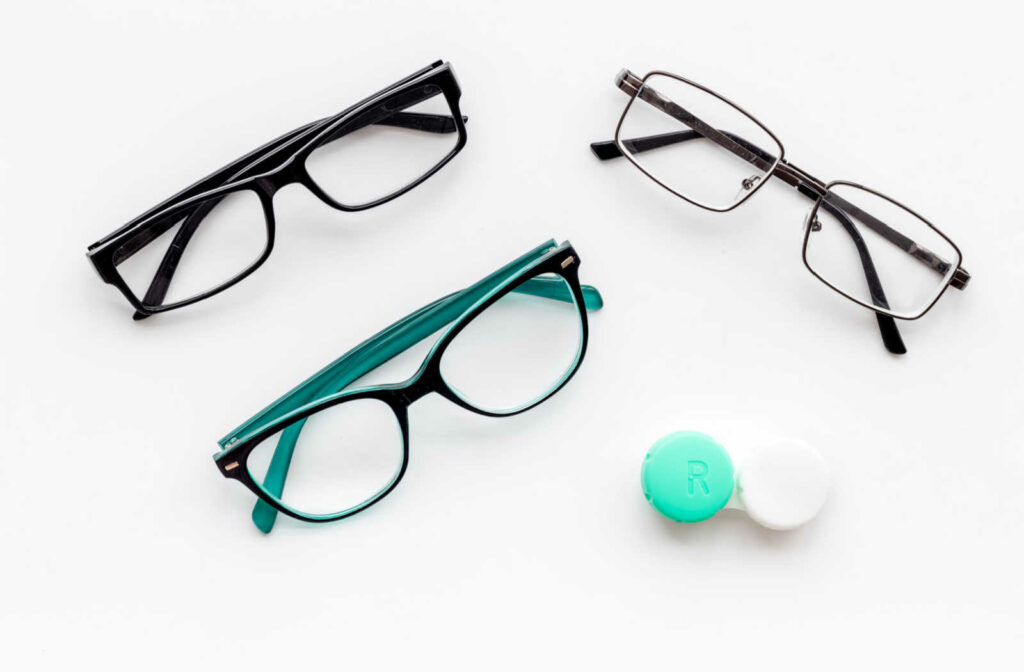How Lens Thickness Affects Your View
Many patients prefer contact lenses over eyeglasses because of the way they look. Contact lenses can provide an unobstructed view and allow everyone else a clear view of your face.
Some patients consider thick eyeglasses a nuisance, but what about thick contact lenses? When an optometrist prescribes contact lenses for a higher prescription, does the lens get thicker?
Why Some Lenses Thicker
A higher prescription corresponds to a more severe refractive error. For example, a patient with low myopia may have a prescription of -0.25 diopters (D). In contrast, someone with high myopia may have a -5.00 D prescription. A higher refractive error requires a lens with greater focusing power.
The lens curve creates focusing power. The shape is designed to mimic the curve of a healthy cornea or compensate for an abnormal eyeball length. Higher prescriptions need more lens material to alter how light enters the eye.
Refractive errors, including myopia (nearsightedness) ad hyperopia (farsightedness), occur when an abnormal eyeball length or cornea shape causes light to focus incorrectly within the eye. A prescription lens controls how light is refracted and directs it onto the retina (tissue located at the back of the eye).
Regular lenses for eyeglasses can get frustratingly thick with higher prescriptions—earning the name “Coke bottle” glasses. Fortunately, modern eyewear designers have created lens materials capable of bending light more efficiently. High-index lenses can be lighter and thinner than regular lenses with the same strong prescription.
With a modern solution available for thinner eyeglasses, what about modern contact lenses? While contact lenses get thicker with prescription, the same thickness problems are less common because the lenses work differently.

Glasses vs. Contact Lenses
A thicker lens is designed to create enough focusing power to correct a higher prescription. Yet, a prescription lens for contact lenses is much thinner than a lens for eyeglasses. So, when a person switches between wearing eyeglasses and contact lenses, shouldn’t the lenses have the same thickness?
Although a patient may alternate between options for the same vision problem, the prescriptions are not the same. A significant reason for the difference in thickness is where the lens rests relative to the eye.
Generally, eyeglasses rest about 12 mm away from the eye. A contact lens is positioned directly on the eye, so the lens doesn’t need to compensate for the distance.
Imagine looking through a window. You have an obstructed view if you’re standing directly in front of the window. Peek over to the left or right, and you can see even more. However, when you move further away from the window, your view of the outside becomes increasingly limited. Tilting to the left or right may improve your view somewhat, but the window frame can get in the way.
Eyeglasses need more surface area to provide efficient lens power, typically greater than 46 mm in diameter. However, the surface area dedicated to focusing power can be significantly smaller for contact lenses. The optic zone of a contact lens is approximately the same diameter as the pupil or 9 mm.
With glasses, the entire lens contributes to focusing power. Contact lenses feature a centre area (optic zone) for vision correction and an outer skirt to support lens fit.
Another reason eyeglasses are thicker is safety requirements. A glasses lens that’s too thin might shatter with impact. Generally, eyeglasses have a minimum centre thickness of 1.0 mm or greater. While thickness for contact lenses depends on prescription needs, the average contact lens centre is less than 0.1 mm.
Soft vs RGP Thickness
There’s a significant thickness difference between eyeglasses and contact lenses, but thickness also varies with contact lens type.
Soft contact lenses are made with a flexible plastic polymer material that conforms to the shape of the eye. As a result, the lenses are thinner and easier to adapt to than rigid gas permeable (RGP) lenses. However, the thinner material makes them less durable and may not be a good fit for people with significant astigmatism.
RGP contact lenses are made from sturdier material allowing the shape to remain constant even when you blink. The rigid material provides sharper vision correction but can be more challenging to adapt to for first-time wearers. RGP lenses are thicker than most soft contact lenses but still significantly thinner than the slimmest eyeglasses lens.
The more significant thickness can make patients more aware of the lens positioned in the eye. Thicker soft contact lenses for higher prescriptions may take longer to adapt to than thinner soft lenses. But, generally, the skirt is effective in improving comfort. Whether or not a patient feels comfortable with a thicker contact lens depends on their cornea sensitivity.
Contact Us for Your Lens Fitting
How your contact lenses fit is crucial to how your lenses function and feel regardless of thickness. A thicker lens can sometimes be more challenging to fit, especially if you have a sensitive cornea. At Avenue Optometry & Vision Therapy, we want your vision to be clear and comfortable. We can work with you to find a fitting solution, whether your lenses are thick or thin.
Request an appointment today with the North York eye doctors at Avenue Optometry & Vision Therapy!




